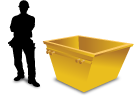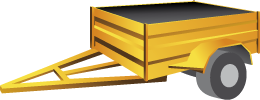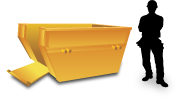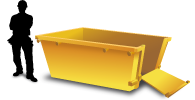Skip Size Estimator
Estimate the size of skip bin that you need
Estimating the size of skip bin required for a particular job is often difficult especially if the material is distributed around the house, rather than having been placed in a measurable pile.
Skip bin sizes are always expressed in cubic metres (never tonnes). The following information should serve as a rough guide to help you estimate the size of skip bin that you require.
The table below shows approximate equivalences of cubic metres to the well known sizes of a box trailer and a wheelie bin.
| Cubic Metres | Standard Trailer | Wheelie Bin |
|---|---|---|
2 Cubic Metre |
2 *  |
8 * |
|
3 cubic metres |
3 *  |
12 * |
4 cubic metres  |
4 *  |
16 * |
6 cubic metres  |
6 *  |
24 * |
Typical Jobs
From our experience we have found that the sizes often required for typical jobs are as follow:
Bathroom renovation
 You are normally going to be disposing of
cabinetry, old shower screen, curtain rail, some floor tiles, some wall tiles, possibly a
bath tub and the packaging that your new materials were shipped in. Over the course of
hundreds of bathroom renovation jobs we have found that the most commonly used size
is a 3 cubic metre skip.
You are normally going to be disposing of
cabinetry, old shower screen, curtain rail, some floor tiles, some wall tiles, possibly a
bath tub and the packaging that your new materials were shipped in. Over the course of
hundreds of bathroom renovation jobs we have found that the most commonly used size
is a 3 cubic metre skip.
Kitchen renovation
 The volume generated by kitchen renovations
varies more than that of bathroom renovations because the size of kitchens is more variable
than that of bathrooms. The waste generated generally consists of cabinetry and old bench
tops, possibly a stove and dishwasher, floor coverings such as tiles or vinyl, wall tiles
and packaging that your new materials arrived in. We have found the most commonly
used sizes of skip are 3 or 4 cubic metres.
The volume generated by kitchen renovations
varies more than that of bathroom renovations because the size of kitchens is more variable
than that of bathrooms. The waste generated generally consists of cabinetry and old bench
tops, possibly a stove and dishwasher, floor coverings such as tiles or vinyl, wall tiles
and packaging that your new materials arrived in. We have found the most commonly
used sizes of skip are 3 or 4 cubic metres.
Moving house (large cleanup)

If you are moving and plan on throwing out
any furniture or whitegoods bikes or exercise equipment and the like, as well as general
junk items, you will probably need a 4 to 6 cubic metre skip.
Moving house (small cleanup)

If you are only throwing out general junk
items, you will probably need about a 3cubic metre skip.
Deceased estate

If you are clearing out a house completely,
you will often require total capacity of more than 20 cubic metres to remove all the
material.
Excavation projects
 If
you are excavating material such as soil to be put in a
skip bin, it is relatively easy to estimate the quantity. As a rule of thumb work out the
volume of the undisturbed excavated material by multiplying length * width * and then
multiply again by 1.3 to allow for packing inefficiency. Note: soil tends to weigh in order
of 1.5 tonnes per cubic metre, so if in doubt please check with us first to make sure that
the maximum lifting capacity of the truck is not exceeded.
If
you are excavating material such as soil to be put in a
skip bin, it is relatively easy to estimate the quantity. As a rule of thumb work out the
volume of the undisturbed excavated material by multiplying length * width * and then
multiply again by 1.3 to allow for packing inefficiency. Note: soil tends to weigh in order
of 1.5 tonnes per cubic metre, so if in doubt please check with us first to make sure that
the maximum lifting capacity of the truck is not exceeded.
Excavations tend to (rather inconveniently) not be in a the shape of regular rectangular prism but, don't worry too much about the exact volume, as the packing efficiency is always going to be approximate anyway. Just use your best guess as to the dimensions. Often if you are cutting away a region of lawn for instance, you will need to estimate the average depth of cut.
Demolished brickwork or concrete
 Multiply
length * width * depth to get the volume demolished then multiply again by 1.5 to allow for
packing inefficiency. Note: brickwork and concrete tend to weight in order of 1.5 tonnes
per cubic metre.
Multiply
length * width * depth to get the volume demolished then multiply again by 1.5 to allow for
packing inefficiency. Note: brickwork and concrete tend to weight in order of 1.5 tonnes
per cubic metre.